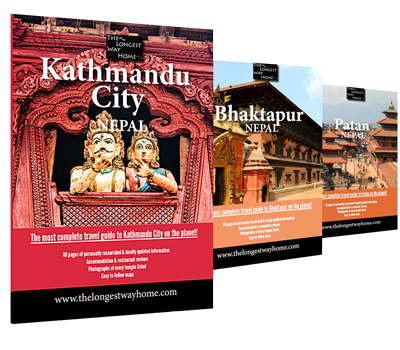About Budhanilkantha
Budhanilkantha is situated 8 km north of Kathmandu in the village of Narayanthan. It lies at the base of the forested peak of Shivapuri, a well-known trail that offers weather-dependent views of the Himalayas. Budhanilkantha is renowned for its temple, which features a large reclining stone statue of Vishnu at its center.

Today, Budhanilkantha is a popular destination for both Hindu and Buddhist pilgrims and tourists eager to visit the famous statue. For casual visitors, there isn't much else to do unless it serves as a stopping point en route to Shivapuri. However, if you have a free morning, you can add to your itinerary the experience of visiting Nepal's largest statue!
There are several small, local Nepali-style restaurants in the vicinity and small shops for water and snacks. The surrounding area is characterized by typical concrete-style architecture.
Budhanilkantha
Did you know?
Vishnu is often depicted as having a pale blue complexion and having four arms. Despite the name having similarities to Buddha, Budhanilkantha actually means “Old Blue Throat”.
History of Budhanilkantha
The Budhanilkantha statue carries several intriguing tales. Some historical records suggest that it was sculpted in the 7th century and transported to the area by Vishnu Gupta, who was serving under King Bhimarjuna Dev of the Licchavi dynasty.
An alternative legend recounts a farmer and his wife who discovered the statue while plowing a field. Upon unearthing a stone that seemed to bleed, they found it to be the missing Budhanilkantha statue, which they then relocated to its current site.
Not a single king of Nepal has visited Budhanilkantha since King Pratap Malla (1641–1674), who had a prophetic dream warning him against the consequences of royal visits to the temple. Since then, no monarch has dared to set foot there.
Regarding the "floating" nature of the statue, numerous scientific and archaeological efforts have been thwarted on religious grounds, as the statue is considered sacred and should not be disturbed. A single test conducted on a fragment of stone from the statue indicated that it might be composed of silica, similar to lava, and potentially capable of floating.
What's Inside Budhanilkantha Temple?

The Budhanilkantha temple is an open space without a roof. Access is gained through a stone gateway, with a large painted concrete fence to the left. Below the fence is a long pond containing the statue of Vishnu, which emerges just above the water's surface. Made from black basalt, the statue of Vishnu as Narayan stands 5 meters tall (16.4 feet). Adorned with robes and a headdress featuring an image of Buddha at its center, the statue rests upon a bed of stone serpents. This central image signifies the unity of Hindu and Buddhist faiths.
There is one entrance leading to the statue and another exit on the opposite side.
Visitors, particularly foreigners, are generally permitted access to the statue as long as they dress modestly, behave respectfully, and refrain from taking photographs. However, security personnel can be vigilant and may not be accustomed to tourists. A clear view of the statue can usually be obtained from between the fence.
Around the outer concrete fence, several smaller shrines to Shiva, Saraswati, and Ganesh are situated. Animal sacrifices are frequently performed here, especially on Saturdays.
Entrance Fee
Currently, there is no entrance fee to Budhanilkantha. Please note that this may change in the future.

Please be aware that non-Hindus are sometimes informed that they cannot visit the statue, despite the fact that the statue is accessible to Nepali Buddhists. The guards may default to the safer option of denying entry. Having a Nepali-speaking companion can be helpful in such situations.
During the Haribondhini Ekadashi Mela festival, thousands of pilgrims visit the temple, as this is believed to be the time when Vishnu awakens from his slumber. It's advisable not to visit during this event due to the large crowds. The festival occurs on the 11th day of the Hindu month of Kartika, which falls in October–November. If you plan to visit Nepal during this period, inquire about the festival dates as they may vary slightly.
Note: Cameras and mobile phones are not permitted inside the pond area. Photography is allowed within the compound and outside the fence.
Directions to Budhanilkantha
Address: Budhanilkantha, Narayanthan, Kathmandu, Nepal
Taxi: Traveling from Kathmandu to Narayanthan takes approximately 30-40 minutes due to traffic. Departing early in the morning can help avoid this congestion.
Bus: Microvans depart from Lazimpath and Kantipath every 5 minutes for 20+ rupees. The vehicles are less crowded near Lazimpath compared to Civil Mall. Ask the conductor for directions to Narayanthan. There is a small bus park near the gates to Budhanilkantha. It's common to combine a visit to Budhanilkantha with a hike to Shivapuri.
Map to Budhanilkantha
Is Budhanilkantha Worth Visiting?
If you identify with Hinduism, Buddhism, or have a particular interest in Vishnu, then Budhanilkantha is a must-visit destination.
However, if you have already explored many temples and heritage sites in Kathmandu, a dedicated trip to Budhanilkantha might feel somewhat underwhelming, primarily because of the traffic congestion in Kathmandu.
If you are traveling to Shivapuri, then including a stop at Budhanilkantha is definitely worth the effort.
Download my guidebooks to Nepal
Liked this page? You'll love my books! They are hands on guidebooks that are better than the rest. Yes, really! In them I cover all attractions with step-by-step accuracy using well researched information, photographs and travel tested walking tours.
Available in print or digital editions - the best guidebooks for visiting Nepal.
Was this page helpful to you? If so please tell others!



